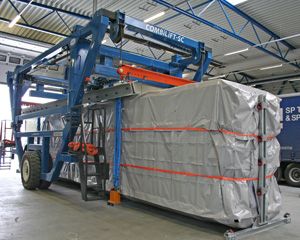 Combilift consulted with Andresen to identify its straddle carrier as the one-machine solution for tower manufacturer's two sites. |
Combilift has helped Danish Andresen Towers address the logistical challenges in manufacturing and moving extreme lengths of product, which form the basis of Andresen's new tower construction.
Andresen Towers is part of the IAI Group, with more than 25 years of experience in the production of steel towers. The company has recently taken its original concept a stage further with the design of its patented shell towers, and has set up two new production and warehouse facilities in Denmark, which cover an area of 25,000 sqm (269,098 sqft.).
CEO Tom Andresen says to make wind energy a more competitive alternative to fossil energy sources, the company has harnessed its technology to build the next generation of much higher towers. "These exploit better wind conditions to generate a larger output which in turn reduces costs."
Traditional tubular welded towers are limited to a diameter of 4.3 m (14.1 ft.) due to the existing road infrastructure, but Andresen's larger diameter tower sections are bolted together on site, and can be easily carried on ordinary trucks or in 45 containers. This avoids extra costs for special transport, reduces disruption to traffic and enables the shipment of towers to previously inaccessible areas.
Safe and efficient handling and storage of loads up to 14 m (46.0 ft.) long, 3.3 m (10.8 ft.) wide - and weighing up to 30 T - was also an issue.
Combilift consulted with Andresen's management to identify the Combilift straddle carrier as the one-machine solution for the two sites. Each straddle carrier was adapted to take into account the slightly differing loads, with one model built with a larger frame to cope with double-stacked containers.
Andresen did not want to invest in pieces of equipment that could only carry out one specific job. So options like a combination of mobile cranes and traditional counterbalance forklifts, or reach stackers were discounted. He was also focused on the total cost of ownership.
According to Combilift, a major advantage of the straddle carrier compared to other comparable machines is its much lower weight and therefore greatly reduced ground pressure.
"Our calculations based on a 10-year operating lifetime took in initial capital outlay, fuel consumption, service costs and the reduction in wear and tear on the surfaces, and proved that we could achieve major operational savings compared to using any other type of equipment," says Andresen.
The machine's dimensions and its three-wheel manoeuvrability enable it to access the production area to load crates containing up to seven steel shells, weighing from 1.3 T to 3.25 T each. It can then load onto heavy goods vehicles without the need for a crane. It also handles incoming containers of components manufactured elsewhere. A spreader beam attachment with different lift points enables varying sizes of loads to be lifted.
Combilift's Logistic Services also assisted the company with layout diagrams to rationalise storage of Andresen's yearly output, which was paramount as the window for installing towers on site is limited to the summer months.